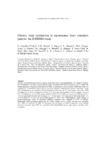Mostrar o rexistro simple do ítem
Chronic renal dysfunction in maintenance heart transplant patients: the ICEBERG study
| dc.contributor.author | González-Vílchez, Francisco | |
| dc.contributor.author | Arizón-del-Prado, José M. | |
| dc.contributor.author | Segovia-Cubero, Javier | |
| dc.contributor.author | Almenar-Bonet, Luis | |
| dc.contributor.author | Crespo-Leiro, María Generosa | |
| dc.contributor.author | Palomo, Jesús | |
| dc.contributor.author | Delgado Jiménez, Juan Francisco | |
| dc.contributor.author | Mirabet, Sonia | |
| dc.contributor.author | Rábago, Gregorio | |
| dc.contributor.author | Pérez-Villa, Félix | |
| dc.contributor.author | Díaz, Beatriz | |
| dc.contributor.author | Sanz, M.L. | |
| dc.contributor.author | Pascual, Domingo | |
| dc.contributor.author | Fuente, Luis de la | |
| dc.contributor.author | Guinea, G. | |
| dc.date.accessioned | 2019-05-03T11:05:18Z | |
| dc.date.available | 2019-05-03T11:05:18Z | |
| dc.date.issued | 2014-02-05 | |
| dc.identifier.citation | González-Vílchez F, Arizón JM, Segovia J, et al. Chronic renal dysfunction in maintenance heart transplant patients: the ICEBERG study. Transplant Proc. 2014; 46(1): 14-20 | es_ES |
| dc.identifier.issn | 0041-1345 | |
| dc.identifier.uri | http://hdl.handle.net/2183/22816 | |
| dc.description.abstract | [Abstract] Chronic renal dysfunction (CRD) is a major complication after heart transplantation. We sought to describe the renal function over time, to assess the risk factors associated with CRD development, and to evaluate the clinical attitudes on diagnosis and treatment of CRD. A retrospective, cross-sectional, multicenter study was conducted in 13 outpatient clinics in Spain. A total of 244 heart recipients who survived more than 2 years after transplantation were included. Post-transplantation follow-up was 7.7 years (range: 2-22 years). CRD was diagnosed in 32.4% of patients at a mean of 3.3 years after transplantation. Serum creatinine increased 0.1 ± 0.2 mg/dL per year in CRD group compared with 0.0 ± 0.2 mg/dL per year in non-CRD group (P = .003) and glomerular filtration rate decreased −1.5 ± 4.3 mL/min/1.73 m2 per year in CRD group versus −0.1 ± 4.8 mL/min/1.73 m2 per year in non-CRD group (P = .027). After CRD diagnosis, major changes in immunosuppression based on calcineurin inhibitors reduction were instituted in 46.8% of patients. Multivariate model identified recipient age (P < .0001), female sex (P = .0398), and time since transplant (P < .0001) as predictors of CRD. In conclusion, the prevalence of CRD in long-term heart recipient survivors was quite high. CRD was associated with nonmodifiable factors (age, gender, and time since transplant). | es_ES |
| dc.language.iso | eng | es_ES |
| dc.publisher | Elsevier | es_ES |
| dc.relation.uri | https://doi.org/10.1016/j.transproceed.2013.09.031 | es_ES |
| dc.rights | Atribución-NoComercial-SinDerivadas 3.0 España | es_ES |
| dc.rights.uri | http://creativecommons.org/licenses/by-nc-nd/3.0/es/ | * |
| dc.subject | Creatinine | es_ES |
| dc.subject | Heart failure | es_ES |
| dc.subject | Heart transplantation | es_ES |
| dc.subject | Kidney failure | es_ES |
| dc.title | Chronic renal dysfunction in maintenance heart transplant patients: the ICEBERG study | es_ES |
| dc.type | info:eu-repo/semantics/article | es_ES |
| dc.rights.access | info:eu-repo/semantics/openAccess | es_ES |
| UDC.journalTitle | Transplantation Proceedings | es_ES |
| UDC.volume | 46 | es_ES |
| UDC.issue | 1 | es_ES |
| UDC.startPage | 14 | es_ES |
| UDC.endPage | 20 | es_ES |
Ficheiros no ítem
Este ítem aparece na(s) seguinte(s) colección(s)
-
INIBIC-ICATC - Artigos [177]






